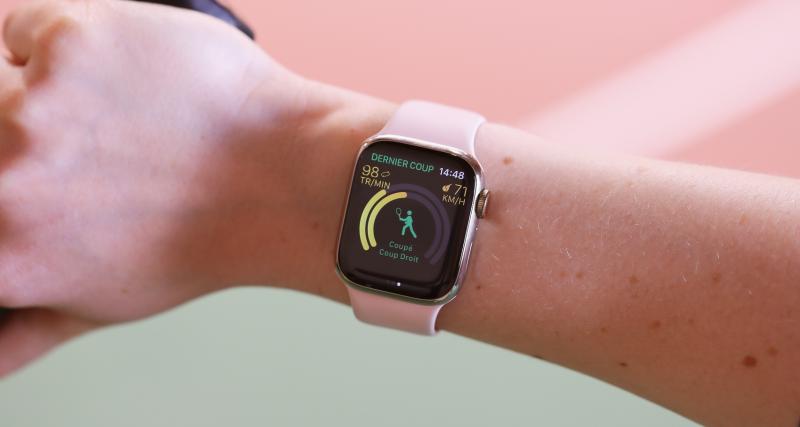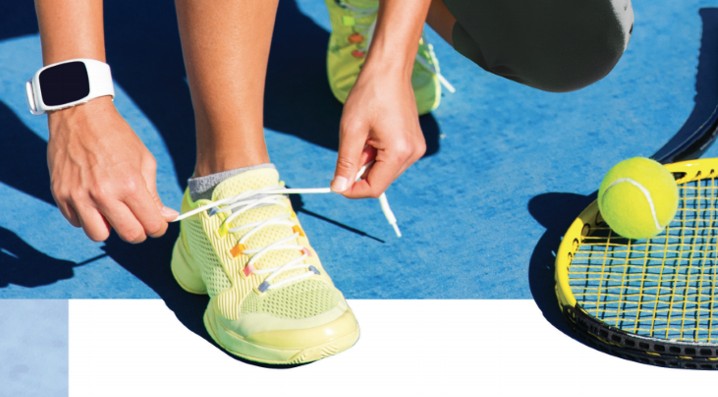
Think about the following questions.
1. How much exercise do you do every day? How do you measure it?
2. Would wearing a fitness tracker motivate you to exercise? Why or why not?
3. What are the advantages of fitness trackers? Are there any disadvantages?
VOCABULARY PREVIEW
Match each New Academic Word List(NAWL) word with the correct definition.
- feedback
- indicator _____
- elaborate _____
- systematic _____
- quantitative _____
- pulse _____
- a. using a careful system or method
- b. a sign of something
- c. information regarding performance
- d. the heartbeat as it is felt elsewhere in the body
- e. of or relating to measurement in numbers
- f. complicated; sophisticated
WEARABLE FITNESS TRACKERS

What do fitness trackers have in common with gaming controllers? In June of 2015, Fitbit CEO James Park had something worth keeping track of besides his footsteps. The Fitbit initial public offering (IPO) was among the strongest of the year. The company's stock prices soared in the first hours of trading and retained their value after the hype1 wore off. Fitbit was at the forefront of a new wave of health and fitness products: fitness trackers.
Electronic fitness trackers are a cross between medical biometric devices like the EKG machine, which tracks the heart's electrical activity, and a personal trainer. Based in part on the motion sensors in gaming controllers, the devices and their accompanying software can track a range of variables. These include steps taken, floors climbed, pulse rate, calories burned, hours spent standing, and hours spent sleeping restfully. Fitness trackers can even provide encouragement. The Fitbit platform2, for instance, awards "badges3" to users when they reach certain milestones, such as losing five pounds. These devices promise users a more precise and systematic way to pursue their goals.
Trackers are becoming increasingly popular. A 2020 Pew Research Center survey found that one-fifth of adults polled use them as part of their exercise routine. And initial evidence suggests they may really help. The basic concept of counting steps has been around for quite a while with the pedometer, a simple electronic device that performs only that function. Although fitness trackers have more elaborate features, they all include pedometers. Counting steps is a sort of exercise supervision. Researchers at a London university conducted a years-long study on the effectiveness of keeping track of steps. One group of subjects did not use fitness trackers, while the other did. After four years, the fitness-tracker group did more exercise and had a lower risk of fractures4, heart attacks, and strokes.
Recent data on the dangers of sedentary5 lifestyles may also be driving sales. Because sitting still on the job causes health problems that are irreversible even with regular exercise, many are enlisting the help of fitness trackers. Counting steps and floors climbed at work can help users consciously increase the total amount of movement per day and counteract6 the effects of sitting still in front of a screen.
However, there is by no means an expert consensus on the accuracy of the other types of data that fitness trackers claim to record. Critics have doubts that such a device can correctly measure the number of calories burned. They point out7 that it cannot possibly take into account important aspects of a person's body, including body fat percentage and metabolism8. This led some experts to question whether fitness trackers have really improved on the simpler (and much cheaper) pedometer.
Worse than being a little off, some fitness-tracker features bother health professionals because of what they see as meaningless metrics9. The sleep tracking modes of some devices, for instance, are attached to the wrist. By recording movement throughout the night, these trackers supposedly measure periods of rest and wakefulness, quantifying10 the amount of restful sleep the user is getting. That would be a very useful feature—if wrist movement were an accurate indicator of sleep quality. But sleep researchers point out that brain waves, which the trackers cannot record, are the only good quantitative measure of how restful sleep is.
One thing everyone can agree upon is that exercise works. Every little bit counts, and many people do seem to be motivated by feedback from the devices. An old saying in management is, “That which is measured improves." So while the difference in value between a $10 pedometer and a $100 fitness tracker may be debatable, either one is better than nothing.
New Academic Word List
- hype 1 : n. talk or writing intended to make people excited about something; publicity
- platform 2 : n. an operating system
- badge3 : n. a small object awarded for a particular accomplishment
- fracture 4 : n. a partial or complete break in a bone
- sedentary 5 : adj. not physically active
- counteract 6 : v. to act against something; to cause something to have less of an effect
- point out 7 : v. to tell someone a fact
- metabolism 8 : n. all the chemical processes in your body, especially the ones that use food
- metric 9 : n. a standard of measurement
- quantify 10 : v. to measure the quantity of
READING COMPREHENSION
A ‣ Mark each statement as true (T) or false (F) according to the reading.
- Wearable fitness trackers were becoming popular by 2015.
- True
- False
- Most fitness trackers include EKG machines.
- True
- False
- One study showed that counting steps had long-term benefits.
- True
- False
- Fitness trackers may not be reliable counters of calories burned.
- True
- False
- One unexpected effect of these devices is more restful sleep.
- True
- False
B ‣ Choose the best answer according to the reading.
- What is the main idea of the reading?
- a. Fitness trackers are popular and seem to motivate people to exercise more.
- b. Fitness trackers are a waste of money, and you would be better off with a pedometer.
- c. Fitness trackers have some serious problems accurately tracking calories burned.
- d. Fitness trackers have developed from simple pedometers with the addition of motion sensors.
- Which of the following is NOT true of Fitbit?
- a. James Park is the CEO.
- b. The company's IPO was in 2015.
- c. Its platform gives users digital "badges."
- d. The company's share prices were a result of hype.
- The word it in paragraph 5 refers to _____.
- a. device
- b. amount
- c. accuracy
- d. doubt
- Why do sleep experts criticize the sleep functions of some fitness trackers?
- a. They are too expensive.
- b. They measure the wrong thing.
- c. They are no better than pedometers.
- d. They fail to measure wrist movement.
C ‣ The following terms are explained in the reading. Write definitions for them.
- EKG machine:
_____ - pedometer:
_____ - sedentary lifestyle:
_____
SUMMARY
Fill in the blanks with the phrases in the box.
- sedentary lifestyles
- count steps
- track fitness goals
- motion sensors
- calories burned
- brain waves
|
Definition
|
|
Popularity
|
|
Downsides
|
VOCABULARY PRACTICE
Fill in the blanks with the words in the box. Change the form if necessary.
- elaborate
- feedback
- indicator
- systematic
- pulse
- quantitative
- _____ measures like test scores may not be the best way to evaluate a student's progress.
- It is important to not only take _____ gracefully but to use it in order to improve.
- A person's IQ is a fairly accurate _____ of academic and professional potential.
- If you find someone unconscious, you should immediately check for a(n) _____ .
- Instead of guessing at your monthly expenditures, find a(n) _____ way to record them.
- The couple wants a simple ceremony at home rather than a(n) _____ and expensive wedding.
SUPPLEMENTAL READING
Exergaming

Parents often face a difficult time prying children away from video screens and getting them outdoors for some good old-fashioned exercise. But these parents could actually use kids’ love of gaming to get them moving. Exergaming, a combination of physical exercise and video games, makes exercise much more appealing.
A few exergames were released in the 1980s but met with limited success. The first hit exergaming device was Konami's fun and affordable Dance Dance Revolution, which came out in 1998. Players stood on a platform and tapped colored arrows with their feet in tune to musical and video cues. Then in the mid-2000s, exergaming really took off. The Nintendo Wii offered players virtual participation in sports like baseball, tennis, and bowling. And CompuTrainer invited riders on a trip through a virtual landscape on a stationary bike—an idea that has had many imitators, including the hugely popular Peloton.
Today, fitness clubs, schools, and community centers in several countries offer exergaming machines. Some schools even include exergaming workouts alongside traditional PE classes. And although parents are happy to see their children exercising, many still worry.
Health experts also have mixed views. "Exergames burn calories, raise heartbeats, and offer a physical benefit for kids," says Lisa Hanson, co-director of a Florida research laboratory. But she adds that it is unclear whether active gaming offers the same benefits as traditional workouts. A recent British study found that many Nintendo Switch fitness games, for example, don’t provide intense enough exercise.
Fill in the blanks with information from the reading.
- The history of exergaming goes all the way back to _____ .
- The CompuTrainer was a(n) _____ that takes users through a virtual landscape.
- Many health experts are not convinced that exergaming has the same benefits as _____ .






















Leave a comment
Load more